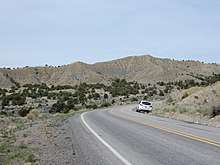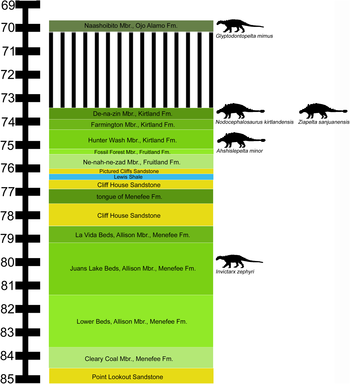Lewis Shale
The Lewis Shale is a geologic formation in the Western United States. It preserves fossils dating back to the Campanian tp Maastrichtian stages of the late Cretaceous period.
| Lewis Shale Stratigraphic range: Campanian to Maastrichtian | |
|---|---|
 Hills underlain by Lewis Shale near Cuba, New Mexico. | |
| Type | Formation |
| Sub-units | Dad Sandstone Member, Huerfanito Bentonite Bed, Teckla Sandstone Member. |
| Underlies | Pictured Cliffs Formation |
| Overlies | Mesaverde Group |
| Thickness | 600 m |
| Lithology | |
| Primary | Shale |
| Other | Sandstone |
| Location | |
| Region | Mountain states, United States |
| Country | |
| Type section | |
| Named for | Fort Lewis (former Army installation in La Plata County, Colorado) |
| Named by | Charles Whitman Cross, A.C. Spencer, and C.W. Purington |

Description
The Lewis Shale is an olive-gray marine shale with some thin beds of claystone, siltstone, sandstone, and limestone. It was deposited in the Western Interior Seaway in the late Cretaceous.[1] The formation crops out in the Bighorn Basin, Green River Basin, Powder River Basin, San Juan Basin, and Wind River Basin. In the San Juan Basin, the formation has a maximum thickness of over 600 meters[2] in the northern part of the basin, but pinches out in the southern part of the basin.[3] It is the stratigraphically highest marine shale in the basin.
In the Green River Basin, the formation is also up to 600 meters thick and is divided into upper and lower shale members by the Dad Sandstone Member.[4]
Fossils
The formation is relatively poor in fossils.[1] However, the formation contains fossils of the ammonites Baculites clinolobatus[5], Baculites asper,[2] and Rhaeboceras.[6]
Economic geology
The Lewis Shale in the San Juan Basin has historically been a minor source of natural gas. However, there is growing interest in increasing the production of this formation via hydraulic fracturing. While only sixteen wells were completed into the Lewis Shale before 1990, there were over 101 well completions by 1997.[7]
History of investigation
The formation was named by Charles Whitman Cross and A.C. Spencer in 1899 for outcrops near Fort Lewis, Colorado.[2]
Footnotes
- National Park Service 2015
- Cross and Spencer, 1899
- Beaumont et al. 1956
- Hale 1961
- Roehler 1993
- Cobban 1988
- Dubiel 2013
References
- Beaumont, E.C., Dane, C.H., and Sears, J.D., 1956, Revised nomenclature of Mesaverde group in San Juan basin, New Mexico: American Association of Petroleum Geologists Bulletin, v. 40, no. 9, p. 2149-2162. [Available online, with subscription, from AAPG archives: http://www.aapg.org/datasystems or http://search.datapages.com]
- Cobban, W.A., 1988, The Upper Cretaceous ammonite Rhaeboceras Meek in the Western Interior of the United States: U.S. Geological Survey Professional Paper, 1477, 15 p.
- Cross, Whitman; Spencer, A.C.; Purington, C.W. (1899). "La Plata folio, Colorado". Geologic Atlas of the United States. GF-60.
- Dubiel, R.F., 2013, Geology, sequence stratigraphy, and oil and gas assessment of the Lewis Shale Total Petroleum System, San Juan Basin, New Mexico and Colorado, chap. 5 of U.S. Geological Survey San Juan Basin Assessment Team, Total petroleum systems and geologic assessment of undiscovered oil and gas resources in the San Juan Basin Province, exclusive of Paleozoic rocks, New Mexico and Colorado: U.S. Geological Survey Digital Data Series 69–F, p. 1–45.
- Hale, L.A., 1961, Late Cretaceous (Montanan) stratigraphy eastern Washakie basin, Carbon County, Wyoming, IN Wiloth, G.J., and others, eds., Symposium on Late Cretaceous rocks, Wyoming and adjacent areas: Wyoming Geological Association Field Conference Guidebook, no. 16, p. 129-137.
- "Lewis Shale". Chaco Culture National Historical Park, New Mexico. National Park Service. 2015. Retrieved 8 June 2020.
- Roehler, H.W., 1993, Stratigraphy of the Upper Cretaceous Fox Hills Sandstone and adjacent parts of the Lewis Shale and Lance Formation, east flank of the Rock Springs uplift, southwest Wyoming: U.S. Geological Survey Professional Paper, 1532, 57 p., (incl. geologic maps, scale 1:100,000)